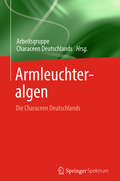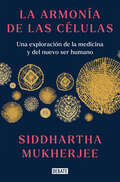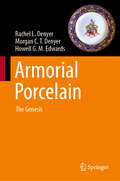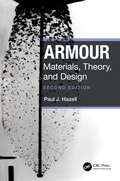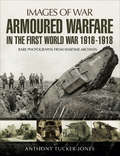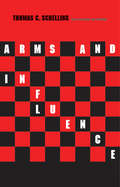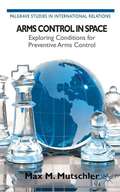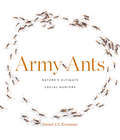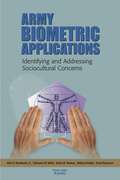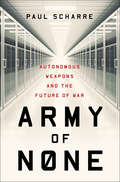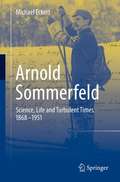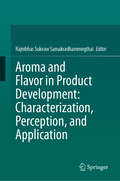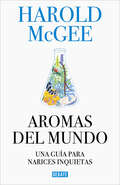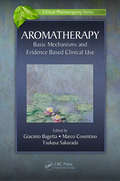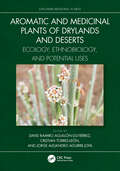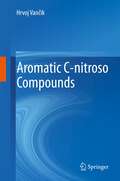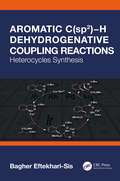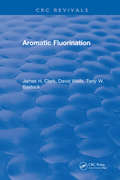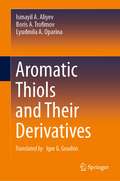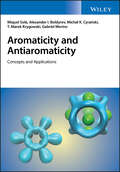- Table View
- List View
ARMIX sukaldean: Mugaritzen laguntzarekin
by Elhuyar Elhuyar FundazioaHaurrentzako zientzia liburua
Armleuchteralgen: Die Characeen Deutschlands
by Arbeitsgruppe Characeen DeutschlandsDieses Buch beschreibt umfassend die Armleuchtergewächse Deutschlands. Von der Paläontologie bis zum Naturschutz ist alles in diesem Band enthalten: Bestimmungsschlüssel, Artkapitel, Fundortübersicht , Bioindikation, Systematik und Ontogenese. Alle Kapitel sind von Spezialisten des jeweiligen Gebietes verfasst.
La armonía de las células: Una exploración de la medicina y del nuevo ser humano
by Siddhartha MukherjeeTras los éxitos de El emperador de todos los males y El gen, Siddhartha Mukherjee se adentra en la increíble y apasionante historia de la célula. «En un relato a la vez lírico y amplio, Mukherjee nos lleva a través de una historia de la comprensión humana: desde el descubrimiento en el siglo XVII de que estamos formados por células hasta la actual tecnología de vanguardia para manipular y desplegar células con fines terapéuticos».The New Yorker Bienvenidos a la apasionante historia de la célula. En este nuevo libro, el oncólogo y divulgador Siddhartha Mukherjee nos acompaña en un viaje fascinante a partir de uno de los mayores descubrimientos científicos de la historia: el hecho de que todos los organismos vivos complejos estén constituidos por unidades diminutas, autónomas y autorreguladas, esas que en el siglo XVII Robert Hooke vio a través de su microscopio y bautizó con el nombre que hoy conocemos. Aquel hallazgo, seguido de una cada vez mejor comprensión de la fisiología celular, cambió para siempre (y aún determina) la manera en que abordamos la medicina, la ciencia, la biología, las estructuras sociales y hasta la cultura. Una fractura de cadera, una parada cardiaca, el Alzheimer, el sida, un cáncer de pulmón... todo, absolutamente todo, puede explicarse como el resultado del funcionamiento anómalo de las células o de los ecosistemas que estas forman. Y también todo debería poder tratarse mediante su manipulación terapéutica. Esta revolución en el campo de la biología celular ya ha demostrado resultados transformadores y hoy se plantea como uno de los avances científicos que más vidas pueden salvar. Críticas:«Maravillosamente ambiciosa. La biología de la célula es compleja y colosal como la vida misma. No creo que ningún escritor pudiera tratar este asunto mejor».The Times «En parte misterio, en parte historia de aventuras, La armonía de la célula es una irresistible incursión en los confines de la ciencia médica y un recordatorio del poder del ingeniohumano que probablemente dejará a los lectores asombrados y esperanzados».Jennifer Egar, autora ganadora del Pulitzer «La escritura de La armonía de la célula es tan agradable que te dejas llevar por su música».The New York Times «Con una investigación profunda, La armonía de la célula es un extraordinario viaje a través de la historia de los descubrimientos hasta llegar a la medicina celular más innovadora que se practica en la actualidad y a la promesa de lo que está por venir».Paul Nurse, Premio Nobel de Fisiología y Medicina en 2001 «Un narrador extraordinariamente dotado. Las ideas del autor sobre el futuro próximo de la medicina son tan convincentes como inspiradoras. Otro éxito de Mukherjee».Publishers Weekly«Una exploración fiable, oportuna y, lo que es más importante, biológicamente precisa de lo que significa ser humano».The Guardian
Armorial Porcelain: The Genesis
by Howell G. Edwards Rachel L. Denyer Morgan C.T. DenyerThis book explores the genesis of armorial porcelain manufacture in Britain. While heraldic devices began appearing on Chinese porcelain from the sixteenth century onwards, armorials did not appear on British porcelain until the 1750s. It examines the development of porcelain in China and traces its introduction to Western Europe. The book delves into the market for armorial porcelains, from the early commissioning of Chinese armorial porcelainware to the establishment of manufactories in England capable of producing armorial porcelain. It also discusses the reasons behind the timing of armorial porcelain's manufacture in Britain. Additionally, it assesses armorial porcelain as a contemporary historical source. Building upon previous research by the authors, the book presents armorial porcelain as a distinct and highly personalized product. By integrating detailed genealogical research, cultural insights, and chemical analysis, it offers a comprehensive understanding of armorial porcelain within the context of heritage, culture, and science.
Armour: Materials, Theory, and Design
by Paul J. HazellUpdated throughout for the new edition, Armour: Materials, Theory, and Design covers extant and emergent protection technologies driving advances in armour systems. Covering materials, theory and design, the book has applications in vehicle, ship, personnel and building use.Introducing a wide range of armour technologies, the book is a key guide to the technology used to protect against both blasts and ballistic attacks. Chapters cover bullets, blasts, jets and fragments, as well as penetration mechanics. The new edition builds on the previous one, discussing ceramics and metallic materials as well as woven fabrics and composite laminates. Detailing modern technology advancements, the second edition has also been expanded to include improved explanations on shock mechanisms and includes significantly more figures and diagrams.An essential guide to armour technology, this book outlines key ways to implement protective strategies applicable for many types of conflict.
Armoured Warfare in the First World War 1916-18: Rare Photographs From Wartime Archives (Images of War)
by Anthony Tucker-JonesA hundred years ago, on 15 September 1916, on the Western Front during the Battle of the Somme, the tank made its debut on the battlefield. The first tanks were crude, unreliable, vulnerable weapons, but they changed the character of land warfare forever, and Anthony Tucker-Jones's photographic history of these pioneering armored vehicles is the ideal introduction to them. In a selection of over 150 archive photographs he offers a fascinating insight into the difficult early days of this innovative new weapon, describing its technical history and its performance in combat. While the Battle of Cambrai in 1917 is often held up as the first large-scale tank battle, tanks had already served at Flers-Courcelette on the Somme, during the Nivelle offensive and the battles of Messines and Passchendaele. His book shows that the development of the tank was fraught with technical obstacles and battlefield setbacks. It was invented by the British and the French at almost the same time to help break the deadlock of trench warfare, and the British deployed it first in 1916. Belatedly the Germans followed the British and French example. The initial designs were continuously refined during two years of intense warfare. Finding the right balance between power and weight, getting the armament right, and working out the best tactics for tanks on the battlefield was a tricky, often deadly business.
Arms and Influence
by Prof. Thomas C. SchellingThe author concentrates in this book n the way in which military capabilities real or imagined are used, skillfully of clumsily, as bargaining power. He sees the steps taken by the U. S. during the Berlin and Cuban crises as not merely preparations for engagement, but as signals to and enemy, with reports from the adversary's own military intelligence as our most important diplomatic communications.
Arms and Influence (Veritas Paperbacks)
by Thomas C. Schelling&“This is a brilliant and hardheaded book. It will frighten those who prefer not to dwell on the unthinkable and infuriate those who have taken refuge in stereotypes and moral attitudinizing.&”—Gordon A. Craig, New York Times Book Review Originally published more than fifty years ago, this landmark book explores the ways in which military capabilities—real or imagined—are used, skillfully or clumsily, as bargaining power. Anne-Marie Slaughter&’s new introduction to the work shows how Schelling&’s framework—conceived of in a time of superpowers and mutually assured destruction—still applies to our multipolar world, where wars are fought as much online as on the ground.
Arms Control in Space
by Max M. MutschlerThis book puts the widely-held view that 'arms control in space is not possible' to the test and aims to explore how, and under what conditions, arms control could become a reality. Drawing upon international regimes and IR theory, Mutschler examines the success of space weapons and anti-ballistic missiles.
Arms Production In Japan: The Military Applications Of Civilian Technology
by Reinhard DrifteAlthough Japan's arms industry is still relatively small, significant political, economic, and technological developments indicate its growing importance and pave the way for Japan's increasing involvement in arms production. In this comprehensive study, Dr. Drifte examines both the domestic and international environments that are encouraging Japan
Army Ants: Nature's Ultimate Social Hunters
by Daniel J. KronauerA richly illustrated, captivating study of army ants, nature’s preeminent social hunters.A swarm raid is one of nature’s great spectacles. In tropical rainforests around the world, army ants march in groups by the thousands to overwhelm large solitary invertebrates, along with nests of termites, wasps, and other ants. They kill and dismember their prey and carry it back to their nest, where their hungry brood devours it. They are the ultimate social hunters, demonstrating the most fascinating collective behavior.In Army Ants we see how these insects play a crucial role in promoting and sustaining the biodiversity of tropical ecosystems. The ants help keep prey communities in check while also providing nutrition for other animals. Many species depend on army ants for survival, including a multitude of social parasites, swarm-following birds, and flies. And while their hunting behavior, and the rules that govern it, are clearly impressive, army ants display collective behavior in other ways that are no less dazzling. They build living nests, called bivouacs, using their bodies to protect the queen and larvae. The ants can even construct bridges over open space or obstacles by linking to one another using their feet. These incredible feats happen without central coordination. They are the result of local interactions—self-organization that benefits the society at large.Through observations, stories, and stunning images, Daniel Kronauer brings these fascinating creatures to life. Army ants may be small, but their collective intelligence and impact on their environment are anything but.
Army Biometric Applications: Identifying and Addressing Sociocultural Concerns
by Katharine Watkins Webb David Rubenson Elaine M. Newton John D. Woodward Melissa A. BradleyEvery human possesses more than one virtually infallible form of identification. Known as biometrics, examples include fingerprints, iris and retinal scans, hand geometry, and other measures of physical characteristics and personal traits. Advances in computers and related technologies have made this a highly automated process through which recognition occurs almost instantaneously. With concern about its information assurance systems and physical access control increasing, the Army has undertaken an assessment of how it can use biometrics to improve security, efficiency, and convenience. This report examines the sociocultural concerns that arise among soldiers, civilian employees, and the general public when the military mandates widespread use of biometrics. The authors see no significant legal obstacles to Army use of biometrics but recommend that the Army go beyond the provisions of the Privacy Act of 1974 to allay concerns related to this emerging technology. This report should be of interest to those responsible for access control as well as anyone concerned about privacy and technology issues.
Army of None: Autonomous Weapons And The Future Of War
by Paul ScharreA Pentagon defense expert and former U.S. Army Ranger explores what it would mean to give machines authority over the ultimate decision of life or death. <P><P> What happens when a Predator drone has as much autonomy as a Google car? Or when a weapon that can hunt its own targets is hacked? Although it sounds like science fiction, the technology already exists to create weapons that can attack targets without human input. Paul Scharre, a leading expert in emerging weapons technologies, draws on deep research and firsthand experience to explore how these next-generation weapons are changing warfare. <P><P> Scharre’s far-ranging investigation examines the emergence of autonomous weapons, the movement to ban them, and the legal and ethical issues surrounding their use. He spotlights artificial intelligence in military technology, spanning decades of innovation from German noise-seeking Wren torpedoes in World War II—antecedents of today’s homing missiles—to autonomous cyber weapons, submarine-hunting robot ships, and robot tank armies. Through interviews with defense experts, ethicists, psychologists, and activists, Scharre surveys what challenges might face "centaur warfighters" on future battlefields, which will combine human and machine cognition. We’ve made tremendous technological progress in the past few decades, but we have also glimpsed the terrifying mishaps that can result from complex automated systems—such as when advanced F-22 fighter jets experienced a computer meltdown the first time they flew over the International Date Line. <P><P>At least thirty countries already have defensive autonomous weapons that operate under human supervision. Around the globe, militaries are racing to build robotic weapons with increasing autonomy. The ethical questions within this book grow more pressing each day. To what extent should such technologies be advanced? And if responsible democracies ban them, would that stop rogue regimes from taking advantage? At the forefront of a game-changing debate, Army of None engages military history, global policy, and cutting-edge science to argue that we must embrace technology where it can make war more precise and humane, but without surrendering human judgment. When the choice is life or death, there is no replacement for the human heart.
Army Science And Technology For Homeland Security: Report 2
by Committee on Army Science Technology for Homeland Defense--C4ISRShortly after the events of September 11, 2001, the U.S. Army asked the National Research Council (NRC) for a series of reports on how science and technology could assist the Army meet its Homeland defense obligations. The first report, Science and Technology for Army Homeland Security—Report 1, presented a survey of a road range of technologies and recommended applying Future Force technologies to homeland security wherever possible. In particular, the report noted that the Army should play a major role in providing emergency command, control, communications, computers, intelligence, surveillance, and reconnaissance (C4ISR) capabilities and that the technology and architecture needed for homeland security C4ISR was compatible with that of the Army’s Future Force. This second report focuses on C4ISR and how it can facilitate the Army’s efforts to assist the Department of Homeland Security (DHS) and emergency responders meet a catastrophic event.
Arnold Sommerfeld: Science, Life and Turbulent Times 1868-1951
by Michael EckertThe subject of the book is a biography of the theoretical physicist Arnold Sommerfeld (1868-1951). Although Sommerfeld is famous as a quantum theorist for the elaboration of the semi-classical atomic theory (Bohr-Sommerfeld model, Sommerfeld's fine-structure constant), his role in the history of modern physics is not confined to atoms and quanta. Sommerfeld left his mark in the history of mathematics, fluid mechanics, a number of physical subdisciplines and, in particular, as founder of a most productive "school" (Peter Debye, Wolfgang Pauli, Werner Heisenberg, Linus Pauling and Hans Bethe were his pupils, to name only the Nobel laureates among them). This biography is to a large extent based on primary source material (correspondence, diaries, unpublished manuscripts). It should be of particular interest to students who are keen to know more about the historical roots of modern science. Sommerfeld lived through turbulent times of German history (Wilhelmian Empire, Weimar Republic, Nazi period). His life, therefore, illustrates how science and scientists perform in changing social environments. From this perspective, the biography should also attract readers with a general interest in the history of science and technology.
Aroma and Flavor in Product Development: Characterization, Perception, and Application
by Rajnibhas Sukeaw SamakradhamrongthaiOne of the greatest challenges facing food product developers today is that of preserving aroma and flavor stability over time without comprising quality. With Aroma and Flavor in Product Development: Characterization, Perception, and Application, researchers and product innovators will find a thorough elucidation of the dynamic interplay of aroma and flavor in complex formulations across various applications, and of the crucial role of foundational elements in crafting globally appealing products. This guide provides essential insights into perception, formation, and development, enabling developers to enhance food items' organoleptic qualities and thereby provide consumers with an enhanced sensory experience. It is unique in its focus on raw material properties, processing changes, and flavor application tools, offering comprehensive coverage of encapsulation methods, isolation, extraction, and release mechanisms. Employing tools such as gas chromatography and descriptive sensory analysis, the text decodes complex chemical compositions to enable effective communication and replication of desired sensory experiences. Readers will finish this text not only with a strong grasp on the latest insights into aroma and flavor research trends, such as sustainable sourcing and novel extraction methods, but also with a vision for the future of food product development.
Aromas del mundo: Una guía para narices inquietas
by Harold McGeeUn viaje al misterioso mundo de los olores con Harold McGee, autor de La cocina y los alimentos. En esta obra de asombrosa sabiduría y originalidad, Harold McGee destila la ciencia que hay detrás de los olores hasta obtener una guía accesible y muy entretenida sobre los aromas del mundo. Aunando vivencias personales y una rigurosa investigación, incorpora los últimos descubrimientos de la biología y la química, y revela cómo nuestro olfato, un sentido con una poderosa pero ignorada influencia en nuestra vida cotidiana, tiene el poder de exponer detalles invisibles e intangibles del mundo material, y provocar sensaciones extraordinarias. Remontándose a los orígenes de los olores en el espacio interestelar, McGee nos cuenta la fascinante historia de las moléculas que desencadenan nuestras percepciones a diario, responsables de fragancias como los aromas cítricos a cilantro y cerveza y los olores medicinalesa narcisos y erizos de mar, muchas de las cuales existían antes de que ninguna criatura pudiera olerlas. Este libro nos lleva en una aventura sensorial en la que olisquearemos lo ordinario (calle mojada y hierba cortada) y lo apetitoso (pan fresco y chocolate), lo delicioso (rosas y vainilla) y lo desagradable (carne en mal estado y huevos podridos), desde la sulfurosa tierra naciente hace más de cuatro mil millones de años hasta las tenues notas de fenol y formaldehído de nuestros teclados de ordenador. McGee rastrea olores de alimentos, bosques, ríos y flores, y nos muestra con su habitual maestría cómo aprender a detectarlos, identificarlos, valorarlos y combinarlos para transformar nuestra relación con la cocina y los sabores. La crítica ha dicho...«Una guía profundamente investigada de los olores del mundo, que capta hasta sus más volátiles moléculas.»The New York Times «Cada página está repleta del equivalente olfativo de las onomatopeyas. No decepcionará a ningún admirador de los ensayos culinarios de McGee.»The Wall Street Journal «El libro de referencia que hará que todo lo que comas parezca más interesante. Hay fascinación y deleite en cada página».The Sunday Times
Aromatherapy: Basic Mechanisms and Evidence Based Clinical Use (Clinical Pharmacognosy Series)
by Giacinto Bagetta Marco Cosentino Tsukasa SakuradaThis reference provides an up-to-date compilation of background scientific information that advocates the application of currently developed clinical studies of the effects of aromatherapy to the treatment of human diseases such as mild, stress-induced mood disorders, infectious diseases, and age-related disturbances. It presents a rational basis for clinical translations of aromatherapy for treating human diseases in need of safer or more effective therapies and discusses the need for further clinical development in areas where therapy is lacking.
Aromatic and Medicinal Plants of Drylands and Deserts: Ecology, Ethnobiology, and Potential Uses (Exploring Medicinal Plants)
by David Ramiro Aguillón-Gutiérrez, Cristian Torres-León, and Jorge Alejandro Aguirre-JoyaThe description and analysis of the Mexican and other countries desertic plants from the point of view of their use in traditional medicine and their potential use in integrative medicine is the overall theme of this book. Aromatic and Medicinal Plants of Drylands and Deserts: Ecology, Ethnobiology and Potential Uses describes the historic use of drylands plants, botanical and geological classification, also describes the endemic plants used in traditional medicine, going through the most relevant aspects of biomedicine and integrative medicine. The chemical and bioactive compounds from desertic medicinal and aromatic plants and the analytic techniques to determine chemical and bioactive compounds from the medicinal and aromatic plants are reviewed. Ethnobiology is detailed in the present book as well as the importance of the integrative medicine for the ancient and actual cultures. The book represents an effort to keep the ethnobiological knowledge of communities for the use of traditional desertic plants with the actual analytical techniques to unveil the chemical molecules responsible of the biological or biomedical applications. Features: • Describes the endemic plants used in traditional medicine • Includes the chemical and bioactive compounds from desertic medicinal plants • Addresses the analytic techniques to determine chemical and bioactive compounds • Represents an effort to keep the ethnobiological knowledge of communities To execute this book, there are collaborations by authors from different institutions in northern Mexico, which is where the arid and semi-arid ecosystems of the country are found. Although the subject of medicinal plants has been treated from different angles, this book offers a holistic and comprehensive vision of these important organisms of the Mexican desert, thus resulting in an updated work for specialized readers and for those who are beginning in this exciting theme.
Aromatic C-nitroso Compounds
by Hrvoj VančikThis book is designed to collect and review the research covering main directions in investigations of aromatic nitroso compounds in last decades, and to present both, the academic aspects of this chemistry, as well as the open field of its applicability. The book is divided in five chapters. The basic structural properties of the nitroso aromatic molecules are described in the first chapter. The second chapter is an overview of the methods of preparations of aromatic nitroso and polynitroso compounds, including classical synthetic methods and some new preparative approaches. The third part deals with the physico-chemical properties of nitroso aromates and azodioxides, its structure, crystallography, quantum chemical calculations, spectroscopy, typical reactions, and especially it is focused on the dimerizations in the solid-state. In the fourth chapter is represented organometallic chemistry of nitroso aromatic molecules and its applications in catalysis. The last part of the book deals with the behavior of this class of compounds in the biological systems, reactions with biomolecules and the use in toxicology.
Aromatic C(sp2)−H Dehydrogenative Coupling Reactions: Heterocycles Synthesis
by Bagher Eftekhari-SisThis comprehensive text covers the research and development trends in the growing field of aromatic C–H dehydrogenative coupling reactions, leading to different types of heterocycles. The author provides answers to how these coupling reactions occur, what kinds of heterocycles are synthesized, and what their advantages are. The palladium-, rhodium-, iridium-, copper-, cobalt-, ruthenium-, and ferric-catalyzed aromatic C(sp2)–H dehydrogenative cross-coupling reactions are described in detail. A useful reference source for researchers and graduates in the field of heterocyclic chemistry and transition-metal-catalyzed dehydrogenative coupling reactions. Features: Comprehensive volume on the synthesis of benzo-heterocycles via aromatic C(sp2)–H bond activation. Heterocycles are of paramount importance to medicinal chemistry and drug discovery. Provides a comprehensive literature survey on the construction of heterocycles. Reaction procedures and mechanistic explanations are included, which will appeal to those in fine chemicals and pharmaceutical companies.
Aromatic Fluorination (New Directions In Organic And Biological Chemistry Ser. #8)
by James H. ClarkAcademia and industry join forces in Aromatic Fluorination, as an expert from each domain contributes to this new text on fluorination of carbocyclic and heterocyclic rings. The book begins with a discussion of fluorine's unique combination of properties, including size, electronic effects, and hydrophobicity, as well as the historical development of its product applications. It explains methods for introducing fluorine into an aromatic ring, focusing on nucleophilic fluorine transfer reactions. The role of catalysts, solvents, and other variables are examined, and the scope and limitations of the methods are discussed. Of particular interest to those working in non-specialist laboratories, Aromatic Fluorination includes detailed descriptions of the new electrophilic routes to fluoroaromatics, in addition to traditional routes and alternative methods involving radical chemistry. Because one of the most important fluorine-containing substituent is CF3, the book explains routes to benzotrifluorides (ArCF3), including traditional industrial methods and modern alternatives employing C-1 halofluorocarbons and other fluoroaliphatics. An alternative to CF3 is CF3S, and several methods of synthesizing aromatic CF3S-containing molecules are described. Since the successful development and diverse applications of aromatic fluorine compounds have led to the search for new compounds and novel substituents, the incorporation of other substituents is also explored. Aromatic Fluorination concludes with discussion of the factors responsible for the successful development of pharmaceutical, agrochemical and liquid crystal applications and the potential for applications in high-performance polymers and other areas. This section also describes in detail important industrial aromatic fluorination processes and the relative merits of different process technologies and their costs.
Aromatic Thiols and Their Derivatives
by Ismayil A. Aliyev Boris A. Trofimov Lyudmila A. OparinaThis book is devoted to the synthetic and physical chemistry of aromatic thiols and their closest derivatives, sulfides, sulfoxides, sulfones, including those substituted by various functional groups such as acyl and thioacyl, alkoxide, ester, hydroxyl and halogens. In some cases, for comparison, selenium and oxygen analogues are also detailed. The main focus of the book is on synthetic methods, both traditional and new, based on the use of transition metals as catalysts, as well as the reactivity of the compounds obtained. Its addition to the influence of conformational and electronic factors on spectral (NMR, IR, UV, NQR) and electrochemical characteristics of the compounds is presented. Finally, the book describes the application of aromatic thiols and their derivatives as drug precursors, high-tech materials, building blocks for organic synthesis, analytical reagents and additives for oils and fuels. It is a useful handbook for all those interested in organosulfur chemistry.
Aromaticity and Antiaromaticity: Concepts and Applications
by Miquel Solà Alexander I. Boldyrev Michal K. Cyrañski Tadeusz M. Krygowski Gabriel MerinoAromaticity and Antiaromaticity A comprehensive review of the science of aromaticity, as well as its evolution, from benzene to atomic clusters In Aromaticity and Antiaromaticity: Concepts and Applications, a team of accomplished chemists delivers a comprehensive exploration of the evolution and critical aspects of aromaticity. The book examines the new global criteria used to evaluate aromaticity, including the Nucleus Independent Chemical Shift (NICS) index and the electronic indices based on electronic properties. Additional discussions of inorganic aromatic compounds developed in this century, which give rise to new concepts like multifold aromaticity, are included. Three-dimensional aromaticity found in fullerenes and nanotubes, Möbius aromaticity present in some annulenes, and excited state aromaticity are explored as well. This volume explores the geometrical, electronic, magnetic, and thermodynamic characteristics of aromatic and antiaromatic compounds and their reactivity properties. It also provides: A thorough historical overview of aromaticity, as well as simple electronic and structural models Comprehensive explorations of organic and inorganic aromatic compounds, concepts of stability and reactivity, and geometric, energetic, magnetic, and electronic criteria of descriptors of aromaticity Practical discussions of heteroaromaticity, as well as Möbius aromaticity and excited state aromaticity In-depth examinations of sigma, pi, delta, and phi aromaticity Perfect for graduate students, researchers, and academics interested in aromaticity, organometallic chemistry, and computational chemistry, Aromaticity and Antiaromaticity: Concepts and Applications will also earn a place in the libraries of professionals and researchers working in organic, inorganic, and physical chemistry.

